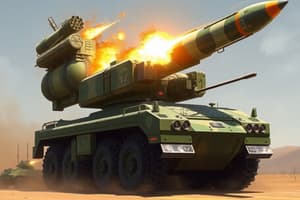Podcast
Questions and Answers
Which of the following is NOT an example of a culturally-attuned information source mentioned?
Which of the following is NOT an example of a culturally-attuned information source mentioned?
- Media broadcast (correct)
- Cultural attaches
- Indigenous leaders
- Atmospheric teams
The detect function occurs primarily before the execution phase of an operation.
The detect function occurs primarily before the execution phase of an operation.
False (B)
What does the IO officer update during the detect function?
What does the IO officer update during the detect function?
high-payoff target list and target synchronization matrix
During the deliver function, the IO officer ensures that the necessary assets are _____ and capable.
During the deliver function, the IO officer ensures that the necessary assets are _____ and capable.
Match the following delivery methods with their descriptions:
Match the following delivery methods with their descriptions:
What is the purpose of assessing engagement during a mission?
What is the purpose of assessing engagement during a mission?
Which of the following best describes the focus of assessment within D3A?
Which of the following best describes the focus of assessment within D3A?
The D3A method is the only methodology available for targeting in military operations.
The D3A method is the only methodology available for targeting in military operations.
The IO officer does not need to keep records of delivery acts and interactions.
The IO officer does not need to keep records of delivery acts and interactions.
What is a key requirement for the delivery aspects of the IO function?
What is a key requirement for the delivery aspects of the IO function?
What does D3A stand for in targeting methodologies?
What does D3A stand for in targeting methodologies?
What is the primary methodology used in Army targeting?
What is the primary methodology used in Army targeting?
The methodology known as 'Find, Fix, Track, Target, Engage, and Assess' is primarily used for _____ targeting.
The methodology known as 'Find, Fix, Track, Target, Engage, and Assess' is primarily used for _____ targeting.
Match the following targeting methodologies with their descriptions:
Match the following targeting methodologies with their descriptions:
The assess function of targeting occurs only during the execution phase.
The assess function of targeting occurs only during the execution phase.
Which of the following is NOT an example of a time-sensitive target?
Which of the following is NOT an example of a time-sensitive target?
What is the purpose of a high-payoff target list?
What is the purpose of a high-payoff target list?
The 'Find, Fix, Finish, Exploit, Analyze, and Disseminate' methodology is mostly used for high-value targets.
The 'Find, Fix, Finish, Exploit, Analyze, and Disseminate' methodology is mostly used for high-value targets.
The four functions of Army targeting methodology are decide, detect, deliver, and ______.
The four functions of Army targeting methodology are decide, detect, deliver, and ______.
During which phase does the detect function primarily occur?
During which phase does the detect function primarily occur?
Why might re-engagement be recommended during an operation?
Why might re-engagement be recommended during an operation?
The targeting process follows a linear structure with no cyclical elements.
The targeting process follows a linear structure with no cyclical elements.
What role does the IO officer play in the targeting team?
What role does the IO officer play in the targeting team?
Match the targeting functions with their primary focus areas:
Match the targeting functions with their primary focus areas:
Flashcards
Assessment in IO
Assessment in IO
Evaluating the effectiveness of information operations (IO) by measuring the impact on the target audience, including behavior change and the need for further engagement.
Lag Time in IO Effects
Lag Time in IO Effects
The delay that can occur between the delivery of an IO message and the observation of its effects.
Dynamic Targeting
Dynamic Targeting
A targeting methodology that focuses on time-sensitive targets and high-value individuals, often requiring rapid response and coordination.
D3A Targeting
D3A Targeting
Signup and view all the flashcards
Find, Fix, Finish, Exploit, Analyze, and Disseminate (F3E2AD)
Find, Fix, Finish, Exploit, Analyze, and Disseminate (F3E2AD)
Signup and view all the flashcards
Engagement in IO
Engagement in IO
Signup and view all the flashcards
Emergent Target of Opportunity
Emergent Target of Opportunity
Signup and view all the flashcards
Hard-to-Reach Target
Hard-to-Reach Target
Signup and view all the flashcards
Targeting
Targeting
Signup and view all the flashcards
IO in Targeting
IO in Targeting
Signup and view all the flashcards
Targeting Cycle
Targeting Cycle
Signup and view all the flashcards
D3A Targeting Methodology
D3A Targeting Methodology
Signup and view all the flashcards
Decide (D3A)
Decide (D3A)
Signup and view all the flashcards
High-Payoff Target List
High-Payoff Target List
Signup and view all the flashcards
Information Collection Plan
Information Collection Plan
Signup and view all the flashcards
Target Selection Standards
Target Selection Standards
Signup and view all the flashcards
Detect Function in Information Operations
Detect Function in Information Operations
Signup and view all the flashcards
Deliver Function in Information Operations
Deliver Function in Information Operations
Signup and view all the flashcards
Execution of Target Synchronization Matrix
Execution of Target Synchronization Matrix
Signup and view all the flashcards
Assessment in D3A (Decide, Detect, Deliver, Assess)
Assessment in D3A (Decide, Detect, Deliver, Assess)
Signup and view all the flashcards
Information Operations (IO) Detect Function
Information Operations (IO) Detect Function
Signup and view all the flashcards
Information Operations (IO) Deliver Function
Information Operations (IO) Deliver Function
Signup and view all the flashcards
Target Synchronization Matrix in IO
Target Synchronization Matrix in IO
Signup and view all the flashcards
Assessment in Information Operations (IO)
Assessment in Information Operations (IO)
Signup and view all the flashcards
Study Notes
Targeting Integration
- Targeting is selecting and prioritizing targets, matching the appropriate response, considering operational requirements and capabilities (JP 3-0).
- Information Operations (IO) is integrated into the targeting cycle, producing effects via the information environment to support objectives.
- The targeting cycle facilitates the engagement of the right target with the right asset at the right time. The IO officer or representative is part of the targeting team and responsible to the commander and staff for all IO aspects.
Targeting Methodology
- Army targeting uses four functions: Decide, Detect, Deliver, and Assess (D3A).
- The Decide function occurs concurrently with planning.
- The Detect function occurs during preparation and execution.
- The Deliver function occurs primarily during execution, with some IO targets engaged during preparation.
- The Assess function occurs throughout the process.
- The targeting process is cyclical, with the command's battle rhythm determining targeting working group meeting frequency.
- The IO officer and IO working group develop IO-related target nominations.
- The IO working group validates IO-related targets before they are nominated to the targeting working group, always scheduled prior.
Decide
- The decide function is part of the planning activity of the operations process.
- Targeting team focuses and sets priorities for intelligence collection and attack planning.
- Commander's intent and concept of operations guide targeting priorities for each phase/critical event of the operation.
- Key products include: High-payoff target list, Information collection plan, Target selection standards, Attack guidance matrix, and Target synchronization matrix.
- High-payoff targets (HPTs) are high-value targets (HVTs) whose loss significantly contributes to the success of friendly actions, focusing on threat command and control nodes and intelligence collection.
- The information collection plan synchronizes four means of information collection, ensured by the G-3/S-3 (with staff coordination) and the G-2/S-2 ensuring all collection assets supply the needed information. IO requirements may have longer lead times.
Other Important Aspects
- Target selection standards establish criteria for when attacks are appropriate.
- Attack guidance matrices specify how/when targets are engaged & desired effects (ranging from asset destruction to changed behavior).
- Target synchronization matrices list HPTs, outlining responsible agencies for detection, attack, and assessment.
- Targeting guidance, separate from IO objectives (which are broader in scope and encompass attack, defend, and stabilization efforts), guides IO officers to select relevant HPTs based on available and anticipated IRCs.
- Mission Analysis involves identifying IO-related HVTs and developing targeting guidance recommendations.
- Intelligence Preparation of the Battlefield (IPB) includes threat force templates, adjustments based on environment, and the identification of threat information capabilities/vulnerabilities to identify HVTs.
- Target value analysis prioritizes targets based on their contribution to friendly objectives and adversary COAs, using spreadsheets and target sheets.
- Deconflicting/Coordinating Targets ensures the attack of any target doesn't interfere with others or inhibit mission accomplishment.
Other Methodologies
- Other targeting methodologies exist to address various missions and units, including Find, Fix, Track, Target, Engage, Assess and Find, Fix, Finish, Exploit, Analyze, and Disseminate.
- Dynamic targeting addresses targets identified too late or not selected for deliberate targeting, focusing on time-sensitive targets.
- The D3A method, also known as Decide, Detect, Deliver, Assess, is used for deliberate targeting, complementing other potential targeting methodologies. An analysis of the need for re-engagement is part of the assessment.
Studying That Suits You
Use AI to generate personalized quizzes and flashcards to suit your learning preferences.
Related Documents
Description
Explore the key concepts of targeting integration and methodology in military operations. This quiz covers the targeting cycle, the role of Information Operations, and the four functions of Army targeting: Decide, Detect, Deliver, and Assess. Assess your understanding of these fundamental processes and principles.




